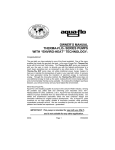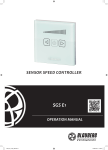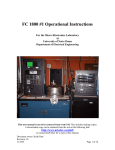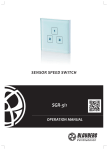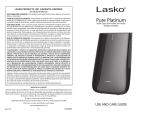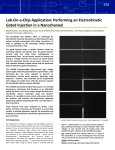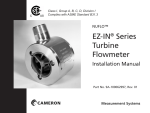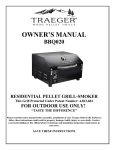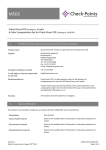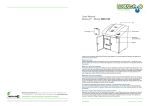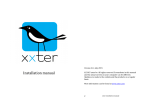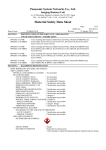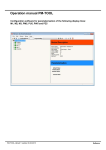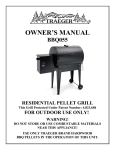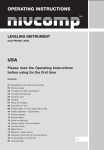Download Demo-30
Transcript
Demo-40 LPH DEMONSTRATION UNIT User’s manual Contents BASU Helthcare 1 Copyright: BASU DEMO-30................................................................................................................................ 1 GENERAL DESCRIPTION........................................................................................................... 3 PRECAUTIONS......................................................................................................................... 3 ELECTRICAL SUPPLY........................................................................................................... PREPARATION OF BRINE (NACL) SOLUTION............................................................................ MANUAL PREPARATION OF 10 LITRES OF SALINE-SOLUTION........................................... CONTROLS AND CONNECTORS................................................................................................ SHUTTING DOWN.............................................................................................................. 3 3 3 4 6 PARAMETERS OF PRODUCED SOLUTIONS............................................................................... 6 ADVISED MAINTENANCE PROCEDURES................................................................................... 6 CELL FLUSHING INSTRUCTIONS......................................................................................... SAFETY................................................................................................................................... SAFETY MEASURES........................................................................................................... 6 7 7 IN CASE OF DIFFICULTY........................................................................................................... 7 CE QUALITY APPROVAL........................................................................................................... 8 MATERIAL SAFETY DATA SHEET 1............................................................................................ 9 MATERIAL SAFETY DATA SHEET 2............................................................................................ 12 MATERIAL SAFETY DATA SHEET 3............................................................................................ 15 CONTACT INFORMATION........................................................................................................ 18 Thank you for purchasing DEMO unit. This unit is based on the ECA technology developed for sterilization, disinfecting and water-purification. Before using the unit, read this instruction manual carefully for obtaining the best results and ensuring safety & health measurements. General Description The DEMO unit is designed to produce on spot electro activated solutions for demonstration purposes. It enables to hand over to clients freshly made acid products and BASOFIT or neutral products. The unit utilizes a cell to electrochemically activate a solution of common salt (NaCL). There are two chambers (anode chamber and cathode chamber) separated by a membrane each having an electrode one positive and one negative. DC current passes through the solution producing products in the positive chamber and BASOFIT in the negative chamber. The strength of the solutions varies according the current flowing between the electrodes and gives different ORP (redox-potential) values, pH and C.ac (active chlorine). The DEMO unit has been developed to manually produce (~30 L/PH) Acidic products and simultaneously (~10L/PH) BASOFIT of different strength (in terms of active chlorine) with a simple change of the flow, the DEMO unit can produce ~40 L/PH neutral products. Precautions - Electrical supply The unit is equipped with a flexible cord plug that meets the requirements of the safety rules. Before connecting the flexible cord to the power point ensure that the power supply and fuses at your place are sufficient to supply the power required for the unit. CAUTION: Dangerous voltage inside. Refer internal servicing to qualified service personnel. To prevent electric shock or fire hazard, remove the power cord from the AC outlet prior to connecting or disconnecting any signal lead, prior to replacing fuse, and prior to altering the set-up of the unit. When you are not using the unit for a long period of time, it is recommended to disconnect the power cord from the AC outlet. 2 Copyright: BASU Note: For safety reasons this unit has an upper current limitation set at 25A meaning that regardless of the strength of the brine the Amps. Meter will never indicate more than 25A. It is advised to pay attention to the brine concentration and reduce it if the Amps meter starts showing amps. reading close to 25A. Preparation of brine (NaCl) solution Manual preparation of 10 litres of saline-solution Fill up a container with 10 liter of softened/filtrated water. Put 60-65g of salt into the container and stir till full saturation. If you need more that 10L take the required amount of water and add salt proportionally (4-7g per 1L of water). Make sure the salt is always well saturated. Mix electrolyte during product generation, if necessary. With 60-65g per 10L of water you can draw ~22-24A, depending on the incoming water mineralization, on the cell which will be displayed on the Amps. meter. When the ampere meter indicates a current of ~20-24 amps one can be sure that products produced consists of ~500mg/l of active chlorine. Should the Amps. meter start displaying readings ~27A, please reduse the amount of salt you use for brine preparation. Controls and connectors 1.) Main power cable. 2.) Power to the pump LED 3.) Amps. meter 4.) Power to the cell RCD 11 5.) Mains power RCD 6.) Mains power LED 7.) Power to the cell LED 8.) Fuses 1 9.) Brine (Acid when flushing) inlet 10.) BASOQUELL / DESANOL / BASOWELL outlet 11.) BASOFIT volume pinch valve 12.) BASOFIT outlet 13.) Bridge 14.) Mode switch (2 – operation, 1- flushing) 15.) Bridge inlet 2 3 4 5 6 14 7 8 12 BASU Helthcare 9 13 10 11 15 Unit in a stand by position ready for commissioning. BASU Helthcare Picture 1 3 Copyright: BASU Unit in a working mode to generate BASOQUELL / DESANOL / BASOWELL and BASOFIT: 1. Immerse brine hose into brine container. 2. Insert BASOQUELL / DESANOL / BASOWELL and BASOFIT tubing 3. Have the pinch valve on the bridge closed. 4. Switch pump and cell RCDs in ON position. 5. Fix mains power switch first in #1 position and after brine starts running from BASOQUELL / DESANOL / BASOWELL and BASOFIT hoses move it to #2 position. BASU Helthcare Picture 2 Unit in a working mode to generate Neutral BASOQUELL / DESANOL / BASOWELL: 1. Move and fix the bridge as shown on the picture 3. 2. Close the vacant hole next to the bridge on the right with the plug. 3. Have pump and cell RCDs ON and mains switch in #2 position. BASU Helthcare Picture 3 Unit in a working mode to generate Neutral BASOQUELL / DESANOL / BASOWELL with BASOFIT isolation for pH correction of ANK BASOQUELL / DESANOL / BASOWELL: 1. Move and fix the bridge as shown on the picture 3 or 4. 2. Close the vacant hole next to the bridge on the right with the plug. 3. Insert BASOFIT tubing (blue) in to the pinch valve and have it open. 4. Have pump and cell RCDs on and mains switch in #2 position. 5. By opening and closing pinch valve you can regulate Ph of ANK- BASOQUELL / DESANOL / BASOWELL in the range 5,5-8,5 depending on the pH of the incoming brine. BASU Helthcare Picture 4 BASU Helthcare Unit in a flushing mode: 1. Prepare a container with ~5% of HCL acid. Discailer or vinegar can be used as well, if HCL acid is not available. 2. Immerse brine, BASOQUELL / DESANOL / BASOWELL and BASOFIT hose in the container with the acid. Have BASOFIT pinch valve fully open. 3. Have the cell RCD(the one on the right) in OFF position. 4. Start the pump by fixing the mains switch in #1 position. 5. Have the acid circulated for about 15-20 min. 6. Flush the unit with water for about 1-2 min. by putting brine hose into container with water and directing BASOQUELL / DESANOL / BASOWELL and BASOFIT hose to drain 7. Have BASOFIT pinch valve closed during this operation. Picture 5 4 Copyright: BASU Note: 1. 2. It is recommended to start demonstration with generation of acidic BASOQUELL / DESANOL / BASOWELL and BASOFIT to avoid a possible air lock in tubing. Switch power to the cell only after you have liquid feely flowing from acidic BASOQUELL / DESANOL / BASOWELL BASOFIT hoses. Important notes: 1. Make sure that the DEMO unit is located vertical, so that the front plate is upright and facing towards you. The unit must be positioned in a vertical position to operate properly. 2. DEMO unit in acidic product generation mode must always produce BASOFIT. Should you have difficulty getting BASOFIT out of the BASOFIT hose, please close BASOQUELL / DESANOL / BASOWELL tube-end (you may do it with our finger) to force flow through BASOFIT tube. By doing this, air locks can be removed. Shutting down When production is completed or brine container is empty, switch off the mains power. Take 1, 5 liter container with water and put the brine tube in and start the unit to flush the cell from the remains of the brine electrolyte. When the bottle with water is empty, switch off pump. Remove power plug from socket. WARNING: Always check that water is flowing through the unit, before switching on the cell! Having power to unit without water flowing may cause serious damage to the electrolyzer. Parameters of produced solutions 1. At ~ 22-24A ~ 30L/PH of BASOQUELL / DESANOL / BASOWELL with active chlorine ~500mg/l pH ~ 2.5-3.5 , ORP~>1100 and ~ 10 L/PH of BASOFIT with pH 11-12,5, ORP ~ -900< 2. At ~ 22-24A ~ 40 L/PH of NEUTRAL BASOQUELL / DESANOL / BASOWELL with active chlorine ~500 mg/l, pH~5,5-8,5, ORP ~780 – 880 mV Advised maintenance procedures Cell flushing instructions Chemicals / Materials needed: 1. Hydrochloric acid (5-7%) 2. Container/jug (~3 Liters) Preparation: 1. Prepare a container/jug with flushing solution. 2. Immerse the brine tube in the flushing solution. 3. Set the unit for BASOQUELL / DESANOL / BASOWELL/BASOFIT generation. 4. Put BASOQUELL / DESANOL / BASOWELL and BASOFIT hose in to the same container/jug with the flushing solution. Flushing with Acid: Follow the procedures as explained in Operation/Flushing chart above. Final Flushing with fresh water: Follow the procedures as explained in Operation/Flushing chart above. Safety Safety measures The production of activated solutions should take place in well ventilated area. (No hermetic closed room) The unit should be kept dry. In case water is spilt on the unit and leaking inside the unit, shut down the unit and dry the unit carefully. There is high voltage present within the unit, which is under no circumstances to be opened when power is switched on. Read the health and safety measures first and ensures that a copy is always available next to the unit or containers. In case of difficulty What may appear to be trouble is not always a real problem. Re-start the unit 3 times. Then make sure first 5 Copyright: BASU FAULT SYMPTOM PROBABLE CAUSE REMEDY OR ACTION Brine solution is not pumped up. Possible problem with power source or broken fuse Ampere meter does not indicate any current Possible problem with power source or broken fuse Ampere-meter displays a lower current as normal. Prepared brine solution is not strong enough. Add NaCl to the brine container. Ampere-meter displays a higher current as normal. Prepared brine solution is too strong enough. Add tap water to the brine container. Ampere suddenly drops to zero Prepared brine solution is too strong and security switch to cell removed power to cell. Add tap water to the brine-container and switch on power to the cell. Current cannot be adjusted to ~22-24 Amps. Core needs to be flushed, a fuse has been blown or brine solution is incorrect. Follow core flushing instructions. Check fuse and brine solution. The ratio between BASOQUELL / DESANOL / BASOWELL and BASOFIT volume is changing. Possible back pressure from tube ends. Large difference in heights of BASOFIT and BASOQUELL / DESANOL / BASOWELL tube ends. Possible airlock in Cathode chamber. Blockage of the cell by scaling Possible back pressure from tube ends. Close BASOQUELL / DESANOL / BASOWELL tube-end to force flow through BASOFIT tube to remove airlocks. Flow output is zero (blocked) Blockage of a tube or scaling of the cell. Possible airlock in Cathode chamber. pH of BASOQUELL / DESANOL / BASOWELL is rising and ORP is decreasing. Not enough BASOFIT being produced to enable ion- exchange BASOFIT feels “warm” Not enough BASOFIT being produced. Possible airlock in Cathode chamber. Follow cell flushing instructions, check tubing inside the unit. Close BASOQUELL / DESANOL / BASOWELL tube-end to force flow through BASOFIT tube to remove airlocks Check if volume of BASOFIT is minimal 10% of total output. Close acolyte hose with your finger for a few seconds to remove a possible air lock from BASOFIT tubing. Open BASOFIT setting to increase BASOFIT volume. Close BASOQUELL / DESANOL / BASOWELL tube end to force flow through BASOFIT tube to remove air locks Flow outputs from unit are decreasing. Particularly volume of BASOFIT is reduced. Check if plug is in socket, check if mains switch is lighted. Check the switch to pump. You may need to replace the fuse. Check if plug is in socket, check if mains switch is lighted. Check the switch to cell. You may need to replace the fuse. Follow cell flushing instructions CE quality approval This appliance is manufactured to conform to the Low Voltage Electrical Equipment and Electrical Safety Regulations and is designed to comply with the requirements of the following EEC Directives: Low Voltage Directive and Electrical Safety Requirements (EN60950) E.M.C Emissions Testing (EN55022) E.M.C Generic Immunity Testing (EN 50082-1) CE Marking LVD Directive (93/68/EEC) Electro Magnetic Compatibility Directive (89/336/EEC) European Low Voltage Directive (73/23/EEC European Machinery Directive (98/37/EEC) Material safety data sheet 1 Neutral BASOQUELL / DESANOL / BASOWELL (91/155/EWG) Section 1: Product and company identification Trade name: Neutral BASOQUELL / DESANOL / BASOWELL Section 2: Composition and information on the ingredients Neutral BASOQUELL / DESANOL / BASOWELL contains active chlorine compounds such as HCLO and CLO- (C.ac in mg/l) in the range of 0,001-0, 09%. The average/standard amount of active chlorine is ~0, 05%. The solution contains no compounds as per the regulations for toxic compounds (67/548/EWG) 6 Copyright: BASU Section 3: Hazards identification The solution is classified as non dangerous accordingly (88/279/EWG) Main Hazards: Neutral BASOQUELL / DESANOL / BASOWELL in its strongest form (C.ac >600mg/l) may cause irritation to the eyes, sensitive skin and throat. Where the solution is stored in bottles one should try to smell or inhale the evaporations. Health effects Eyes: Neutral BASOQUELL / DESANOL / BASOWELL in its strongest form may cause irritation to the eyes. Health effects Skin: Neutral BASOQUELL / DESANOL / BASOWELL in its strongest form may cause slight irritation to sensitive skin or open wounds. Health effects Ingestion: Swallowing of the solution in its strongest form may cause irritation to the throat and digestive tract. Health effects Inhalation: During generation of Neutral BASOQUELL / DESANOL / BASOWELL, particularly its strong form, unless there is adequate ventilation there may be a build up of fumes which may cause dizziness and nausea. Section 4: First aid Measures Eye contact: Where irritation occurs flush with cool fresh water Skin Contact: Where irritation occurs wash the skin wash with soap and warm water Ingestion: Drink cool fresh water to flush through and dilute Inhalation: Remove at once to fresh air if dizziness and nausea persist seek medical attention Section 5: Fire Fighting Measures There are no special requirements for Neutral BASOQUELL / DESANOL / BASOWELL .It is not flammable Section 6: Accidental Release Measures Personal precautions: None. Environmental precautions: The solution is biodegradable and has a limited activation period so there are no potential risks to the environment. Spillage: Wipe up with disposable towels there are no special disposal instructions. Section 7: Handling and Storage Handling: In the area where the solution is being produced there must be good ventilation. Preferably local exhaust ventilation. For those with very sensitive skin it may be advisable to wear gloves. Storage: Store in a cool dry ventilated area in sealed plastic containers and ensure the solution is correctly labeled Section 8: Personal Protection and Exposure Control Engineering control procedures: Where the solution is being generated on site some engineering solutions should be implemented to prevent the build up of fumes particularly where productions facility has inadequate ventilation. Mechanical fume extraction may be advised in this situation. Documented process, safety controls and personnel protection where necessary, gloves, mask etc. Respiratory Protection: Where there is a high risk to fumes build up due to inadequate ventilation in a processing area a respirator should be worn. Hand protection: Where service personnel have sensitive skin the strongest solution may cause irritation and therefore protective gloves should be worn. Eye and facial protection: There are no requirements. Body protection: Normal industrial work wears to avoid exposed skin when handling neat strong solution. Section 9: Chemical and Physical Properties Physical state: Liquid Color and Appearance: Clear, transparent liquid (like water) Odor: Chlorine odor depending on strength of the solution Solubility in water: Completely soluble PH-values: 7, 5-8, 5 Melting-point: 0oC. Boiling-point: 100oC. Fire-focus: N/A 7 Copyright: BASU Flammability: None Explosive: N/A Density: app. 1,000 kg.m3 Steam-pressure: app. 2,330 Pa Section 10: Stability and Reactivity Stability: Stable under all normal storage conditions. Materials to avoid: The solution does not react with other materials Hazardous decomposition products: None Section 11: Toxicological Information Acute toxicity: Not toxic Irritant-Eyes: Data for related material suggests this could produce conjunctivitis irritation Irritant-Skin: Data for related material suggests this may cause skin irritation Reproductive and developmental: None known Skin contact: The possibility of allergic sensitization should be considered Chronic toxicity/Carcinogens: None Human Data: Inhalation may cause respiratory irritation Section 12: Environmental Information Eco toxicity: Destroys bacteria, viruses, spores and algae Degradability and Persistence: Fully Biodegradable Bio-accumulation: None Mobility: None Section 13: Disposal Procedures There are no special disposal procedures. Section 14: Transport procedures Not classified as hazardous for transport Section 15: Regulatory Information Not listed Section 16: Other Information The information in this document meets the European requirements for safety and health measurements. (91/155/EWG) The information contained in this document is based on data considered to be accurate at the time of publication and is given free of charge. It is representative of typical product but batches may exhibit minor variations. NO warranty is expressed or implied concerning the accuracy of this data. In case of doubt or for clarification BASU should be consulted. BASU is unable to anticipate all conditions under which the product may be used, and users are advised to carry out an assessment of workplace risk and carry out their own tests to determine Safety and Suitability for the process and conditions of use. This information is intended for use in the EC-countries only as different limits may be set in other countries. Please check your Local and National Authorities or Supplier. (91/155/EWG) Material safety data sheet 2 A-BASOQUELL / DESANOL / BASOWELL (91/155/EWG) Section 1: Product and company identification Trade name: Acidic BASOQUELL / DESANOL / BASOWELL or A-BASOQUELL / DESANOL / BASOWELL Section 2: Composition and information on the ingredients 8 Copyright: BASU A-BASOQUELL / DESANOL / BASOWELL may contain active chlorine compounds such as CL2 and HCLO (C.ac in mg/l) in the range of 0,001- 0.09%. The average/standard amount of active chlorine is ~ 0, 05%. The solution contains no compounds as per the regulations for toxic compounds (67/548/EWG) Section 3: Hazards identification The solution is classified as non dangerous accordingly (88/279/EWG) Main Hazards: A-BASOQUELL / DESANOL / BASOWELL in its strongest form (C.ac >500mg/l) may cause irritation to the eyes skin and throat. Where the solution is stored in bottles under no circumstances should anyone try to smell or inhale the evaporations. Health effects Eyes: A-BASOQUELL / DESANOL / BASOWELL in its strongest form may cause irritation to the eyes. Health effects Skin: A-BASOQUELL / DESANOL / BASOWELL in its strongest form may cause irritation to the skin or open wounds. Health effects Ingestion: Swallowing of the solution in its strongest form may cause irritation to the throat and digestive tract. Health effects Inhalation: During the generation of the solution particularly its strong form, unless there is adequate ventilation, there may be a build up of fumes which may cause dizziness and nausea. Section 4: First aid Measures Eye contact: Where irritation occurs flush with cool fresh water Skin Contact: Where irritation occurs wash the skin wash with soap and warm water Ingestion: Drink cool fresh water to flush through and dilute Inhalation: Remove at once to fresh air if dizziness and nausea persist seek medical attention Section 5: Fire Fighting Measures There are no special requirements for this solution. It is not flammable Section 6: Accidental Release Measures Personal precautions: None Environmental precautions: These solutions are biodegradable and have a limited activation period so there are no potential risks to the environment Spillage: Wipe up with disposable towels. There are no special disposal instructions. Section 7: Handling and Storage Handling: In the area where the solution is being produced there must be good ventilation. Preferably local exhaust ventilation. For those with very sensitive skin it may be advisable to wear gloves. Storage: Store in a cool dry ventilated area in sealed plastic containers and ensure the solution is correctly labeled. Shelf life is up to 12 months. Section 8: Personal Protection and Exposure Control Engineering control procedures: Where A-BASOQUELL / DESANOL / BASOWELL is generated on site some engineering solutions should be implemented to prevent the build up of fumes particularly if the production facility has inadequate ventilation. Mechanical fume extraction may be necessary in this situation. Documented process, safety controls and personnel protection where necessary, gloves, mask etc. Respiratory Protection: Where there is a high risk to fumes build up due to inadequate ventilation in a processing area a respirator should be worn. Hand protection: Where operatives have sensitive skin the strongest solutions may cause irritation and therefore protective gloves should be worn. Eye and facial protection: There are no requirements Body protection: Normal industrial work wear avoid exposed skin where handling neat strong solution Section 9: Chemical and Physical Properties Physical state: Liquid Color and Appearance: Clear liquid (like water) Odor: Strong Chlorine odor 9 Copyright: BASU Solubility in water: Completely soluble pH-values: 2, 0-3, 5 Melting-point: 0°C. Boiling-point: 100°C. Fire-focus: N/A Flammability: None Explosive: N/A Density: app. 1,000 kg.m3 Steam-pressure: app. 2,330 Pa Section 10: Stability and Reactivity Stability: Stable under all normal storage conditions Materials to avoid: Very corrosive on metals Hazardous decomposition products: None Section 11: Toxicological Information Acute toxicity: Not toxic Irritant-Eyes: Data for related material suggests this could produce conjunctivitis irritation Irritant-Skin: Data for related material suggests this may cause skin irritation Reproductive and developmental: None known Skin contact: The possibility of allergic sensitization should be considered Chronic toxicity/Carcinogens: None Human Data: Inhalation may cause respiratory irritation Section 12: Environmental Information Eco toxicity: Destroys bacteria, viruses, spores and algae Degradability and Persistence: Fully Biodegradable Bio-accumulation: None Mobility: None Section 13: Disposal Procedures There are no special disposal procedures Section 14: Transport procedures Not classified as hazardous for transport Section 15: Regulatory Information Not listed Section 16: Other Information The information in this document meets the European requirements for safety and health measurements. (91/155/EWG) The information contained in this document is based on data considered to be accurate at the time of publication and is given free of charge. It is representative of typical product but batches may exhibit minor variations. NO warranty is expressed or implied concerning the accuracy of this data. In case of doubt or for clarification BASU should be consulted. BASU is unable to anticipate all conditions under which the product may be used, and users are advised to carry out an assessment of workplace risk and carry out their own tests to determine Safety and Suitability for the process and conditions of use. This information is intended for use in the EC-countries only as different limits may be set in other countries. Please check your Local and National Authorities or Supplier. (91/155/EWG) Material safety data sheet 3 BASOFIT (91/155/EWG) Section 1: Product and company identification 10 Copyright: BASU Trade name: BASOFIT Section 2: Composition and information on the ingredients K-BASOFIT contains hydroxyls and hydroxyl radicals such as NaOH, H2O2-,HO-.The solution contains no compounds as per the regulations for toxic compounds (67/548/EWG). Section 3: Hazards identification The solution is classified as non dangerous accordingly to 88/279/EWG. Main Hazards: K-BASOFIT in the strongest form may cause slight irritation of throat. Health effects - Eyes: K-BASOFIT in the strongest form may cause slight irritation to eyes. Health effects - Skin: K-BASOFIT in the strongest form may cause irritation to sensitive skin or open wounds. Health effects - Ingestion: Swallowing of the solution in its strongest form may cause slight irritation to the throat and digestive tract. Health effects - Inhalation: During generation of the solution particularly its strong form unless there is adequate ventilation there may be a build up of fumes which may cause dizziness and nausea. Section 4: First aid Measures Eye contact: Where irritation occurs flush with cool fresh water Skin Contact: Where irritation occurs wash the skin wash with soap and warm water Ingestion: Drink cool fresh water to flush through and dilute Inhalation: Move to fresh air. If dizziness and nausea persist seek medical attention Section 5: Fire Fighting Measures There are no special requirements for these solutions they are not flammable Section 6: Accidental Release Measures Personal precautions: None Environmental precautions: The solution is biodegradable and has a limited activation period so there are no potential risks to the environment Spillage: Wipe up with disposable towels, there are no special disposal instructions. Section 7: Handling and Storage Handling: In the area where the solution is being produced there must be good ventilation. Preferably local exhaust ventilation. For those with very sensitive skin it may be advisable to wear gloves. Storage: Store in a cool dry ventilated area in sealed plastic containers and ensure the solution is correctly labeled. Shelf life up to 12 months. Section 8: Personal Protection and Exposure Control Engineering control procedures: Where K-BASOFIT is being generated on site some engineering solutions should be implemented to prevent the build up of fumes particularly if production facility has inadequate ventilation. Mechanical fume extraction may be necessary in this situation. Documented process, safety control and personnel protection where necessary, gloves, mask etc. Respiratory Protection: Where there is a high risk to fumes build up due to inadequate ventilation in a processing area a respirator should be worn. Hand protection: Where service personnel have sensitive skin the strongest solutions may cause irritation and therefore protective gloves should be worn. Eye and facial protection: There are no requirements. Body protection: Normal industrial work wears to avoid exposed skin when handling neat strong solution. Section 9: Chemical and Physical Properties Physical state: Liquid Color and Appearance: Clear, transparent liquid (like water) Odor: Slight chlorine smell varying with the strength of the solution 11 Copyright: BASU Solubility in water: Completely soluble pH-values: 10-13 Melting-point: 0°C. Boiling-point: 100°C. Fire-focus: N/A Flammability: None Explosive: N/A Density: app. 1,000 kg.m3 Steam-pressure: app. 2,330 Pa Section 10: Stability and Reactivity Stability: Stable under all normal storage conditions. Materials to avoid: The solution does not react with other materials. Hazardous decomposition products: None Section 11: Toxicological Information Acute toxicity: Not toxic Irritant-Eyes: Data for related material suggests this could produce conjunctivitis irritation. Irritant-Skin: Data for related material suggests this may cause skin irritation. Reproductive and developmental: None known. Skin contact: The possibility of allergic sensitization should be considered. Chronic toxicity/Carcinogens: None. Human Data: Inhalation may cause respiratory irritation. Section 12: Environmental Information Eco toxicity: None. Degradability and Persistence: Fully Biodegradable Bio-accumulation: None Mobility: None Section 13: Disposal Procedures There are no special disposal procedures Section 14: Transport procedures Not classified as hazardous for transport Section15: Regulatory Information Not listed Section 16: Other Information The information in this document meets the European requirements for safety and health measurements. (91/155/EWG) The information contained in this document is based on data considered to be accurate at the time of publication and is given free of charge. It is representative of typical product but batches may exhibit minor variations. NO warranty is expressed or implied concerning the accuracy of this data. In case of doubt or for clarification BASU should be consulted. BASU is unable to anticipate all conditions under which the product may be used, and users are advised to carry out an assessment of workplace risk and carry out their own tests to determine Safety and Suitability for the process and conditions of use. This information is intended for use in the EC-countries only as different limits may be set in other countries. Please check your Local and National Authorities or Supplier. (91/155/EWG) Contact information BASU GmbH. – www.basu.at 12 Copyright: BASU












